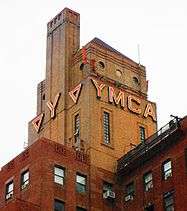Harlem YMCA
|
Harlem YMCA (Claude McKay Residence) | |
|
(2014) | |
   | |
| Location |
180 West 135th Street Manhattan, New York City[1] |
|---|---|
| Coordinates | 40°48′51″N 73°56′30″W / 40.81417°N 73.94167°WCoordinates: 40°48′51″N 73°56′30″W / 40.81417°N 73.94167°W |
| Area | 9.9 acres (4.0 ha) |
| Built | 1931-32[2] |
| Architect | James C. Mackenzie Jr. (architect in charge)[3] |
| NRHP Reference # | 76002143[1] |
| Significant dates | |
| Added to NRHP | December 8, 1976[1] |
| Designated NHL | December 8, 1976[4] |
| Designated NYCL | February 10, 1998 |
The Harlem YMCA, also known as the Claude McKay Residence, is located at 180 West 135th Street between Lenox Avenue and Adam Clayton Powell Jr. Boulevard in the Harlem neighborhood of Manhattan, New York City.

Built in 1931-32, the red-brown brick building with neo-Georgian details was designed by the Architectural Bureau of the National Council of the YMCA, with James C. Mackenzie, Jr. as the architect in charge.[2][3] It replaced the building from 1919 across the street.[3] Inside the building is a mural by Aaron Douglas titled "Evolution of Negro Dance."
The building was declared a National Historic Landmark in 1976,[5][6] and was designated a New York City Landmark in 1998.[2]
History and significance
The Harlem YMCA is a significant landmark of black culture in New York City. Intended primarily for the use of African-American men at a time when most YMCAs were for whites only, it was one of the best equipped YMCAs in the United States.[7]
African-American author Claude McKay lived in the building from 1941 through 1946,[5] Bill Clinton is a current member.[8] and many notable black Americans have stayed at the facility, including Malcolm X – then Malcolm Little – who chose to stay there because of its proximity to his favorite nightclubs.[9]
See also
- List of New York City Landmarks
- National Register of Historic Places listings in New York County, New York
References
Notes
- 1 2 3 National Park Service (2010-07-09). "National Register Information System". National Register of Historic Places. National Park Service.
- 1 2 3 New York City Landmarks Preservation Commission; Dolkart, Andrew S. (text); Postal, Matthew A. (text) (2009), Postal, Matthew A., ed., Guide to New York City Landmarks (4th ed.), New York: John Wiley & Sons, ISBN 978-0-470-28963-1, p.204
- 1 2 3 White, Norval; Willensky, Elliot; Leadon, Fran (2010), AIA Guide to New York City (5th ed.), New York: Oxford University Press, ISBN 9780195383867, p.541
- ↑ "Claude McKay Residence". National Historic Landmark summary listing. National Park Service. 2007-09-10.
- 1 2 ""Claude McKay Residence", by Lynne Gomez-Graves (National Register of Historic Places Inventory)" (pdf). National Park Service. n.d.
- ↑ "Claude McKay Residence--Accompanying photo, exterior, from 1976 (National Register of Historic Places Inventory)" (pdf). National Park Service. n.d.
- ↑ New York Landmarks Preservation Committee plaque, 1999
- ↑ Harris, Bill. One Thousand New York Buildings, Black Dog and Leventhal. 2002. ISBN 1-57912-443-7; p.374.
- ↑ Perry, Bruce. Malcolm: The Life of the Man Who Changed Black America (1992)
External links
 Media related to Harlem YMCA at Wikimedia Commons
Media related to Harlem YMCA at Wikimedia Commons- Official website


